Industry Reports
Veeva 2020 Unified Clinical Operations Survey Report
The Veeva 2020 Unified Clinical Operations Survey Report examines the life sciences industry’s progress toward modernizing clinical operations by gathering the experiences and opinions of more than 500 clinical operations professionals from around the globe. The annual research details the drivers, barriers, and benefits of a unified clinical operating model and tracks the industry’s progress in its move to unify clinical trial systems and processes, and increase stakeholder engagement throughout study execution.
Executive Summary
Findings show the industry is taking action to unify their clinical systems, streamline processes, and simplify information sharing to increase efficiency, quality, and speed in clinical trials.
- Most (98%) respondents report the need to unify clinical applications, and 83% say their organizations have, or plan to have, an initiative in place to do so.
- Standalone, eClinical applications, including EDC (91%), eTMF (78%), and CTMS (64%), are now utilized by most sponsors and CROs as they steadily adopt function-specific technologies to better automate clinical trials.
- All (100%) respondents say they need to improve information sharing between study partners to reduce manual processes (75%), improve visibility and oversight (58%), and speed trials (58%).
- Consistent with the aim to streamline information sharing and speed trials, more than one-third say faster collection of site essential documents (44%) and easier collaboration (42%) are critical to improving study start-up.
- Sponsors and CROs have made significant progress modernizing major clinical areas such as eTMF to increase visibility into TMF status (62%), improve governance and oversight (52%), and ensure a constant state of inspection readiness (52%).
- Organizations that use purpose-built CTMS applications (58%) report better compliance with standards (58%), greater visibility (52%), and improved governance and oversight (48%) compared to those using other methods to manage study execution.
Modernizing Clinical Trials
Modernizing clinical operations is an industry-wide priority, but progress is hindered by legacy clinical systems and processes that slow study execution, limit visibility, and make data sharing and collaboration difficult.1 As the complexity of clinical trials accelerates2 and COVID-19 presents new challenges,3 organizations require greater efficiency and more streamlined approaches to clinical studies.
Nearly all respondents (98%) report the need to unify their clinical trial systems and processes. Of these respondents, 83% have, or plan to have, an initiative to unify their clinical application landscape.
The Number of Organizations with Unification Initiatives Underway
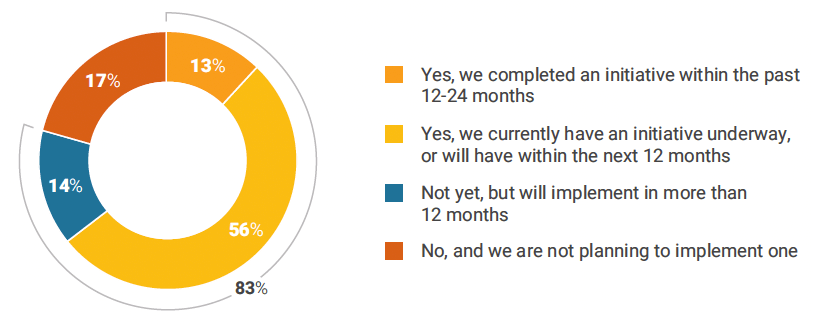
For more than half, the need to unify is driven by better visibility and oversight (70%), reduced manual processes (69%), improved study quality (60%), faster study execution (56%), and improved collaboration (52%).
Top Drivers for Unified Clinical Operations
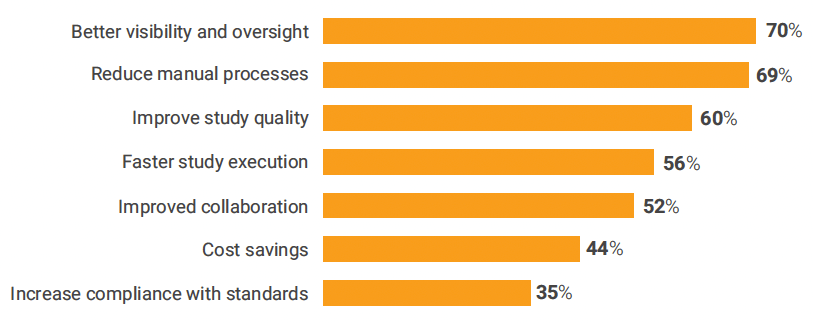
The Evolving Clinical Trial Technology Landscape
On average, respondents use five applications to manage clinical trials, and one-third (33%) use six or more. Highest is EDC, used by 91% of sponsors and CROs surveyed. More than three-quarters (78%) have eTMF applications, up from 59% in 2017. Majorities also use CTMS (64%) and RTSM (63%).
One-third (34%) now use site payments applications, likely due to a growing focus on site satisfaction and retention levels.4 Adoption of newer, purpose-built study start-up applications increased 13-percentage points (27%), from 14% in 2017.
Applications Used to Manage Clinical Studies
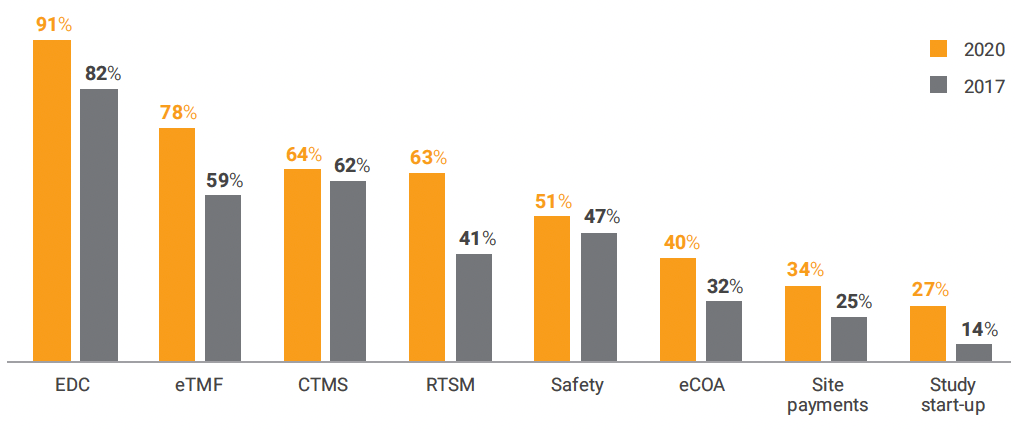
Nearly all (98%) respondents say they have major challenges with their clinical applications. The top three challenges – integrating multiple applications (70%), managing trial information across applications (57%), and reporting across multiple applications (56%) – are likely the result of application and process silos.
Roughly half report issues with ease of use (48%) and a limited ability to support collaboration (45%). This may be due, in part, to the complexity of managing multiple clinical systems across trial processes and study partners.
Biggest Challenges with Clinical Applications

Organizations that have completed initiatives to better integrate/unify their clinical trial landscape report fewer challenges than those with an initiative still underway, most notably reporting across applications (45% versus 66%, respectively), managing/reconciling information across applications (57% versus 67%, respectively), and ease of use (38% versus 50%, respectively).
Driving Operational Efficiencies
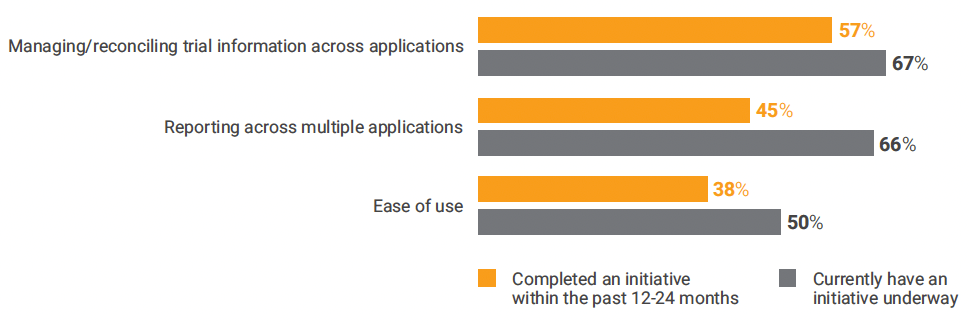
Streamlining Information Sharing
Clinical trials generate significant amounts of information that must be shared and filed in a timely manner to confirm the validity of trial conduct, reduce trial timelines, and improve compliance with regulatory requirements and study protocols.5
All respondents report the need to simplify information exchange with study partners. The primary drivers are reduced manual processes (75%), increased visibility and oversight (58%), faster study execution (58%), and improved study quality (58%).
Top Drivers to Streamline Information Exchange
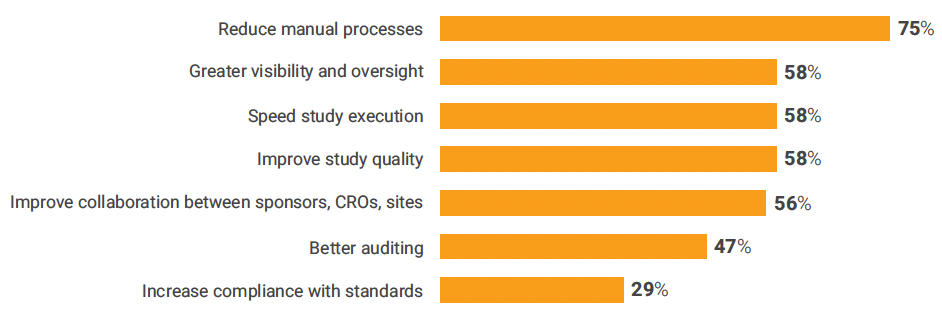
Email is the predominant way sponsors and CROs exchange information with sites (78%), followed by paper shipments (40%), and portals (38%).
Less than one-third rely on eTMF (31%), file share (29%), and ECM applications (15%) to manage information exchange with sites.
Methods Used by Sponsors and CROs to Exchange Information with Sites

Nearly all (99%) report significant challenges with the methods used to exchange information during clinical trials.
Managing information exchange using email and other traditional methods increases administrative effort, reduces efficiency, and limits visibility. These difficulties can contribute to issues respondents have with tracking and reporting (67%), manual processes (64%), and misfiled/missing documents (53%).
Biggest Challenges with Information Exchange

Sponsors are more likely to report challenges with tracking and reporting (71%), and governance and oversight (46%) than CROs (56% and 27%, respectively), perhaps in part, due to sponsor responsibility for adherence to good clinical practice guidelines (GCP) required by ICH E6 (R2).6
Industrywide Focus on Improving Study Start-up
Study start-up is one the most time-intensive areas within clinical drug development, accounting for 61% of total trial lifecycle times.7 Cycle times can be significantly delayed due to paper-based processes, multiple document handoffs between study partners,8 and manual methods of information exchange.
Findings show that study start-up is an area of significant potential to positively impact clinical trials, especially as organizations ramp up for post COVID-19 trial starts.9
All respondents say they need to improve study start-up processes. The top drivers are faster start-up times (75%), reduced manual processes (53%), streamlined contracting and budgeting (51%), and improved site feasibility and selection outcomes (50%).
More than one-third say faster collection of site essential documents (44%) and easier collaboration (42%) will improve study start-up, highlighting the importance of streamlined information sharing and collaboration to trial performance.
Drivers to Improve Study Start-up Processes

Tufts Center for the Study of Drug Development (CSDD) research shows that the early stages of study start-up, like site contracting and budgeting, account for most of the cycle time in the start-up phase and take twice as long today than five years ago.10
As companies increasingly seek global approvals to improve study diversification during the COVID-19 pandemic,11 challenges with country selection, initiation, and regulatory compliance add to these cycle times.12
More than two-thirds (68%) say site contracting and budgeting is their most challenging study start-up process, followed by site identification, feasibility, selection (55%), and IRB/ethics committee approval and planning (46%).
Site essential document collection is an issue for more than one-third of respondents (44%). This may be due, in part, to the prevalence of email and paper shipments to exchange trial documents with sites.
Biggest Challenges with Study Start-up Processes

Majorities (81%) use spreadsheets to manage study start-up processes. Roughly half use eTMF (52%) and CTMS (50%) applications, followed by online survey tools (30%).
One-fourth or less use site portals (24%), purpose-built study start-up applications (24%), or internally developed systems (22%).
Tools Used to Manage Study Start-up
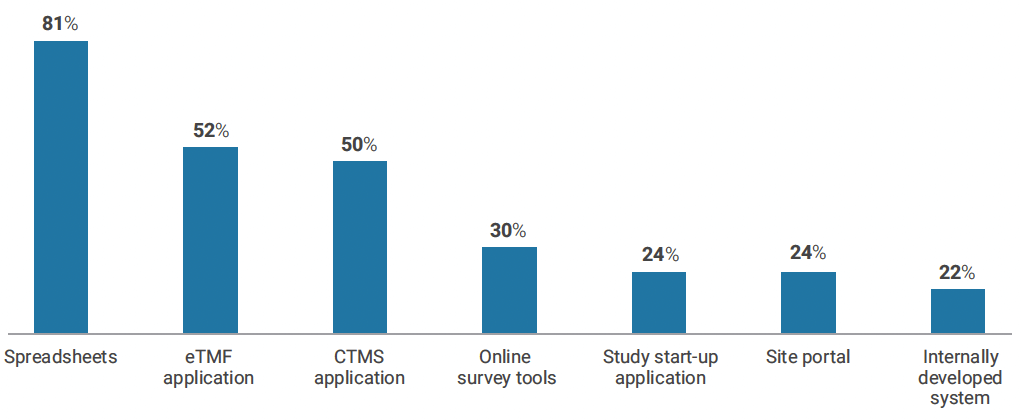
The more tools used to manage study start-up, the more challenges respondents say they have with this process (r=.32, p<.001). On average, respondents use three tools to manage start-up activities and have two challenges.
Number of Challenges with Study Start-up Processes by Number of Tools Used

What are the most challenging, if any, study start-up processes for your organization? Select all that apply. (Q.11)
The predominant use of spreadsheets and other general-purpose methods increases manual effort, as these tools are not purpose-built to manage study start-up processes.
More than half of survey respondents say automating key study start-up processes, like contracts and budgets (63%), site essential document collection (61%), and site initiation and enrollment (53%), will improve trial quality and speed study start-up.
Automating Study Start-up Processes

Active TMF Management and Oversight
Findings indicate positive change is underway as the industry modernizes trial processes with the adoption of purpose-built eTMF applications, which can help to ensure a constant state of inspection readiness, increase visibility, and improve governance and oversight.
The number of respondents using an eTMF application has quadrupled since 2014. More than two-thirds of sponsors and CROs (68%) now use a purpose-built eTMF application, versus 17% in 2014.
eTMF Application Use 2014 - 2019

The growth in eTMF adoption comes as organizations increasingly move away from general purpose methods to manage TMF processes. Today, only 7% use content management systems for TMF management, versus 31% in 2017.
TMF System Used
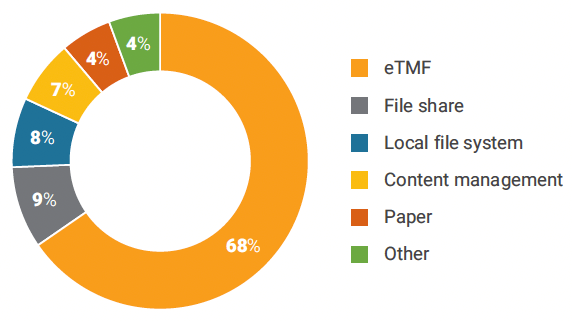
The data suggests the move to modern purpose-built eTMF applications is enabling more ‘active’ trial management. Likely because these newer applications automate processes and manage documents in real-time as they are created, versus acting as static repositories to store and archive document upon completion.
Those using purpose-built eTMF applications report a significant, positive impact on TMF management compared to those using other methods, including visibility into TMF status (62% versus 40%, respectively), tracking and reporting (53% versus 37%, respectively), governance and oversight (52% versus 37%, respectively), and inspection readiness (52% versus 39%, respectively).
Effectiveness of TMF Solutions
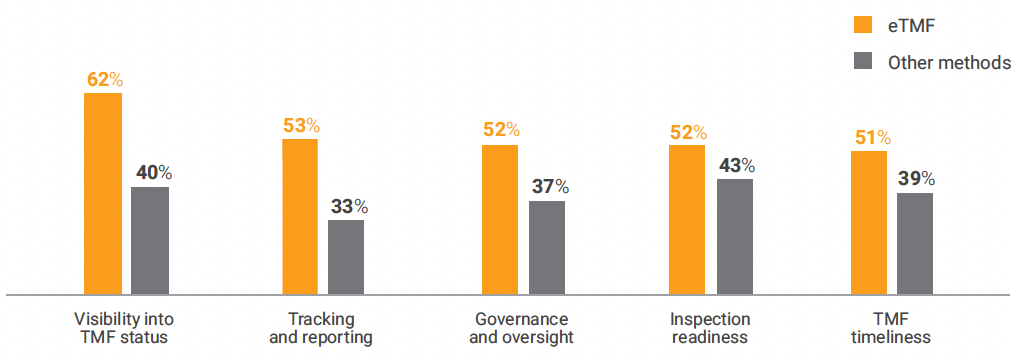
Centralized Governance and Oversight
E6 (R2) GCP guidelines stipulate that the quality and integrity of trial data resides with the sponsor.13 Clinical trial management systems (CTMS) improve visibility into trial status, and enable centralized governance and oversight needed to comply with regulatory requirements.14
More than two-thirds (48%) of sponsors say they use purpose-built CTMS applications to manage clinical studies, followed by spreadsheets and manual trackers (21%), and internally developed systems (12%).
Type of CTMS Solution Used

Findings show that purpose-built CTMS applications are the most effective tool for managing end-to-end clinical trial processes compared with manual trackers, and internally developed systems.
Major areas of advantage include compliance with standards (58% versus 37%, respectively), governance and oversight (48% versus 38%, respectively), and study performance metrics and reporting (46% versus 32%, respectively).
Effectiveness of CTMS Solutions

Conclusion
This research shows that unifying clinical operations is a top priority for improving the quality and speed of clinical trials.
While companies have made progress towards that goal, COVID-19 has accelerated the industry’s efforts to adopt new and more effective business models that drive trial performance.15
As the industry takes action to address the critical need to accelerate study execution, this research underscores the impact of:
- Rapid, collaborative information sharing: There is a tremendous opportunity to simplify information sharing during clinical trials. Unified processes and systems streamline (and where possible, automate) the flow of trial information for improved efficiency and collaboration. Manual handoffs and administrative tasks are reduced, allowing greater focus on trial execution and study quality.
- Optimizing study start-up processes: Study start-up is one of the clinical areas with the most potential to improve trial efficiency and execution. Encouragingly, the adoption of study start-up applications is on the rise and is reducing cycle times by automating and streamlining start-up activities – bringing a higher level of predictability, quality, and speed to clinical trials.
- Increasing study quality and compliance: The industry has made significant progress in its move to unify and modernize its TMF processes for active TMF management and oversight. Documents are managed in realtime as the TMF is generated and a constant state of inspection readiness is achieved, leading to significant improvements in visibility and regulatory compliance.
- Real-time, end-to-end visibility and oversight: Positive change is underway as the industry modernizes its clinical trial management systems on a unified platform to effectively manage and optimize trials. Full visibility across clinical trial processes enables greater oversight and better decision-making needed for faster, higher-quality trial execution.
The clinical trial operating model is changing as the industry reimagines how trials are conducted, driving higher levels of efficiency, quality, and stakeholder engagement. The change underway will enable the industry to embrace new ways of operating that improve study execution, simplify information sharing and collaboration – and ultimately, get safe and effective treatments to patients faster.
Survey Methods
The survey consisted of 19 questions, many of which included sub-questions with response matrices. Survey questions were designed for individuals with knowledge of clinical operations processes and with partial or full responsibility for clinical operations within their organization. The survey was commissioned by Veeva Systems and conducted by Fierce Markets, Applied Clinical Trials, PharmaFocus, and Veeva Systems. Completion of the survey was voluntary. Respondents received a $5 or $10 Amazon gift card and were offered a summary of survey results. No other compensation was offered or provided.
Survey Respondents
Of the approximately 370,000 individuals invited to take the survey, a total of 4,626 surveys were initiated, the majority of which were terminated based on a qualification question gauging the level of responsibility for clinical in their organization. More than 435 unverified responses were eliminated, yielding 524 qualified responses.
Survey Respondent Demographics
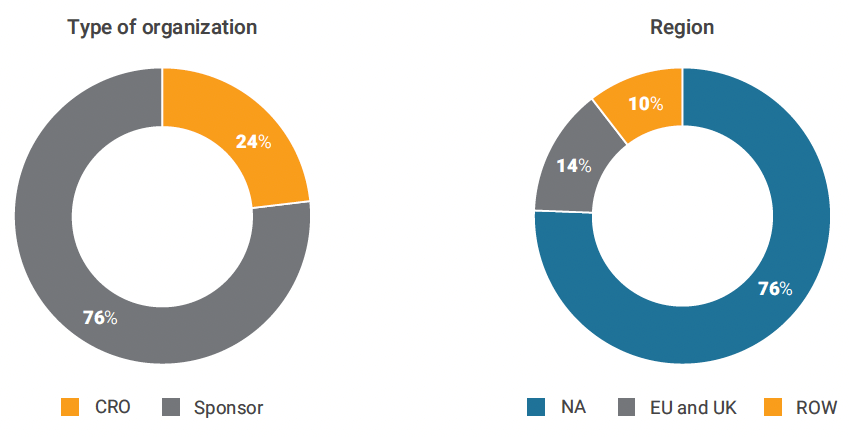
2 Tufts Center for the Study of Drug Development. Impact Report. Volume 20, Number 4. July/August 2018.
3 U.S. Food and Drug Administration. Remarks by Commissioner Stephen Hahn, M.D., June 1, 2020.
4 ScienceDirect. 2017. One and done: Reasons principal investigators conduct only one FDA-regulated drug trial.
5 Good Clinical Practice Network. Chapter 8: Essential Documents for the Conduct of a Clinical Trial.
6 Integrated Addendum to ICH E6 (R1): Guideline for Good Clinical Practice E6 (R2) 2016.
7 Lamberti, Mary Jo. Tufts Center for the Study of Drug Development Impact Report. March 2018.
8 Applied Clinical Trials. The Need and Opportunity for a New Paradigm in Clinical Trial Execution. June 2018.
9 Informa PharmaIntelligence. COVID-19 and the impact on the clinical trial space. May 2020.
10 BioSpace. Site Contracts from Weeks to Months: Results from KMR Groups Site Contracts Study. August 2016.
11 Informa PharmaIntelligence. COVID-19 and the impact on the clinical trial space. May 2020.
12 Lamberti MJ, Wilkinson M, Harper B, Morgan C, Getz KA. Assessing Study Start-up Practices, Performance, and Perceptions Among Sponsors and Contract Research Organizations, Therapeutic Innovation & Regulatory Science, DOI: 10.1177/2168479017751403 tirs. sagepub.com
13 Integrated Addendum to ICH E6 (R1): Guideline for Good Clinical Practice E6 (R2) 2016.
14 Dagalur, Srini. Specialist Leader, Life Sciences for Deloitte Consulting. CTMS: What You Should Know. Applied Clinical Trials. March 2016.
15 U.S. Food and Drug Administration. Statement by FDA Commissioner Dr. Hahn on COVID-19. June 1, 2020..